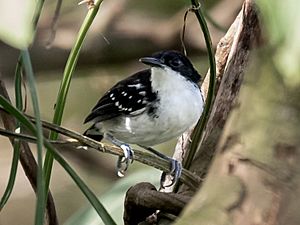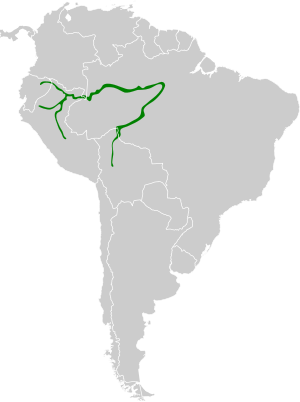Black-and-white antbird facts for kids
Quick facts for kids Black-and-white antbird |
|
|---|---|
 |
|
| A male black-and-white antbird on Marchantaria island, Iranduba, Amazonas state, Brazil | |
| Conservation status | |
| Scientific classification | |
| Genus: |
Myrmochanes
|
| Species: |
hemileucus
|
 |
|
The black-and-white antbird (Myrmochanes hemileucus) is a cool type of bird that belongs to the Thamnophilidae family. It's special because it's the only species in its group, called the Myrmochanes genus. You can find these birds in countries like Bolivia, Brazil, Colombia, Ecuador, and Peru. They love living in warm, wet places like lowland forests and shrublands.
The black-and-white antbird was first described by two English bird experts, Philip Sclater and Osbert Salvin, way back in 1866. They gave it the scientific name Hypocmenis hemileucus at that time.
Contents
What Does the Black-and-White Antbird Look Like?
Black-and-white antbirds are small birds, usually about 11.5 centimeters (about 4.5 inches) long. They weigh between 11 and 13 grams, which is about as much as a few paper clips!
Male antbirds are mostly black on their upper bodies. This black color also covers the area from their jaw to under their eyes. They have a white spot between their shoulder feathers, but it's usually hidden. Their upper wing feathers have white speckles, making them look unique. Their undersides are mostly white, with a little yellowish-brown on their sides and bellies. Their short tail feathers have white tips.
Female antbirds look a lot like the males. However, they have clear white markings near their eyes. They also have more yellowish-brown color on their lower undersides. Both male and female antbirds have long, thin, black beaks. They have gray legs and brown eyes.
Where Do Black-and-White Antbirds Live?
These antbirds live only in the western part of the Amazon region. You can find them along big rivers like the Amazon, Napo, and Ucayali. Their home countries include Bolivia, Brazil, Colombia, Ecuador, and Peru.
Black-and-white antbirds mostly live in the lower parts of the forest, called the understory. They often hang out in thick tangles of vines. Sometimes, they climb up tree trunks to the middle parts of the forest. They are very picky about their homes. While they used to be found mostly on river islands, they can now also live in suitable areas on the mainland. In mainland areas, they sometimes prefer farms over natural habitats.
They often visit areas with specific plants. These include thickets of Tessaria plants, young willow trees, and wildcane. They also like the underbrush of Cecropia trees, especially where there are lots of bindweed vines.
How Do Black-and-white Antbirds Find Food?
Black-and-white antbirds eat small creatures like insects and tiny animals. They have a very interesting way of finding food: they follow army ants! This is called army-ant-following.
When army ants like Eciton burchellii march through the forest, they scare out insects and small animals from the forest floor. The antbirds then catch these creatures as they try to escape. Some birds only follow ants sometimes, while others follow them regularly. Some antbirds even rely completely on army ants to find their food!
Is the Black-and-white Antbird in Danger?
The International Union for Conservation of Nature (IUCN) says that the black-and-white antbird is a species of "least concern." This means they are not currently in serious danger of disappearing.
However, scientists have predicted that these birds might lose a lot of their homes. In Brazil, it's thought they could lose at least half of their habitat. This is mainly because of new buildings and roads being built in their areas.
See also
 In Spanish: Hormiguero negriblanco para niños
In Spanish: Hormiguero negriblanco para niños


